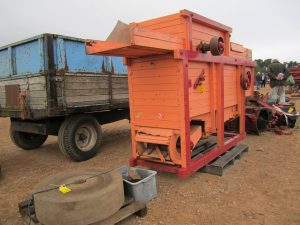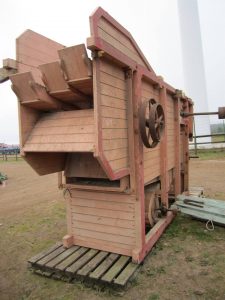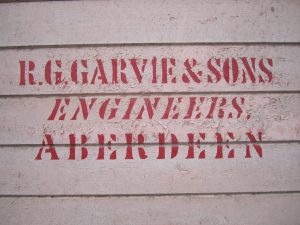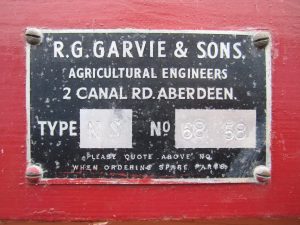The surveyor of the state of agriculture and rural economy of the county of Berwickshire for the Board of Agriculture and Internal Improvement in 1809 provided detailed accounts of the implements and machines developed and used in that county. His account of the threshing mills provides a range of insights into their use among the different social classes, the different types of mills and their history. He states:
 “Threshing mills-Very few farms in this county, of any importance, are now without the almost indispensible accommodation of a thrashing mill, going by eater, wind, or horses. Of late, mention has been made of some driven by the power of steam, but they have not yet reached this county.
“Threshing mills-Very few farms in this county, of any importance, are now without the almost indispensible accommodation of a thrashing mill, going by eater, wind, or horses. Of late, mention has been made of some driven by the power of steam, but they have not yet reached this county.
These machines are now so very universal, that, in a circle of three miles round the residence of the reporter, there are four going by water, four by wind, and ten that are driven by horses. Wind mills, which are very rare in Scotland, because streams are every where to be met with, sufficiient for the universal purpose of corn mills, are now becoming very numerous for thrashing, because streams can seldom be found that will serve for the purpose;a nd they are preferred to horse thrashing mills, especially on large farms, as not interfering with the regular labour. Water is unquestionably the best and most economical power, where it can be had. Of the stem power, for thrashing mills, having no experience whatever, the reporter can give no opinion or account.
Even many small farms have now got small thrashing mills, driven by one or two horses. But hitherto these have not been found to answer nearly so well in proportion, as larger ones, driven by four to six horses. A considerable velocity is required for clean thrashing, which can hardly be given in these small mills, and they require a great many more hands in proportion to attend them, than is required by the larger ones.
 Not being the invention of this county, it does not seem necessary to enter into any minute account of their construction; which besides, would require very detailed description, assisted by numerous drawings, to render intelligible and useful. Several unsuccessful attempts were made, many years ago, to contrive a mechanical view of thrashing; but it seems now fully ascertained, that husbandry owes this most excellently efficient, and highly economical contrivance, to the late Mr Meikle, an ingenious mill-wright in Eat Lothian; who likewise introduced, many years ago, from Holland, the vertical mill for making pearl barley. For these services Mr Meikle never received any public reward; and did not even derive any material renumeration from the profits of his employment.
Not being the invention of this county, it does not seem necessary to enter into any minute account of their construction; which besides, would require very detailed description, assisted by numerous drawings, to render intelligible and useful. Several unsuccessful attempts were made, many years ago, to contrive a mechanical view of thrashing; but it seems now fully ascertained, that husbandry owes this most excellently efficient, and highly economical contrivance, to the late Mr Meikle, an ingenious mill-wright in Eat Lothian; who likewise introduced, many years ago, from Holland, the vertical mill for making pearl barley. For these services Mr Meikle never received any public reward; and did not even derive any material renumeration from the profits of his employment.
The history and progress of this invention certainly belongs to East Lothian; yet it may be proper to remarks that the late William Crow, esq, of nether Bytes in this county, constructed a working model of a thrashing mill, many years before the contrivance of Mr milk, but upon quite different principles. That by Mr Crow consisted of a series of flails or swipes moved by machinery; which was found tolerably efficient, but dangerous to approach, and very liable to break.
Several other attempts to thrash by machinery were made, in several other districts, both of England and Scotland.
Thrashing mills are very various in their powers and performances, from 12 or 18 bushels of grain in an hour, to 30 or even 60 bushels. All of them separate the grain from the straw, by means of two cylindrical rakes, which toss the straw in opposite directions, and finally deliver it into the straw barn; while the shaken out grain and chaff fall through grated hoppers, and pass through at least one winnowing machines, which separates the chaff. The chaff is blown out into a small separate apartment, allotted for its reception, and the grain is delivered into a room with a boarded floor. It is afterwards fully dressed up for market in that corn room, by a separate winnowing machine driven by hand, called manners, and by means of riddles, sieves and rees, to separate the light grain and small seeds from the good grain.
Small threshing mills, to be driven by one horse or two, have been made for from L15 to L30. But there are generally very imperfect instruments; and for the most part, wanting the necessary strength in the connection of their parts together, they soon work loose, and become altogether inefficient. A good, strong, and powerful machine, to go with four or six horses, may be constructed for from L60 to L80; besides the necessary additions to, and alterations of the barn, and the building for supporting the horse wheel; in all from L100 to L150. The building of a tower,the sails of the windmill, and the machinery connecting this with the thrashing mill, may occasion an additional expense of from L150 to L200. The expenses attending a water thrashing mill, as dependant upon a multiplicity of varying circumstances, cannot be averaged.
 Many farmers have a pair of mill-stones connected with the machinery of their thrashing mills, for bruising corn or beans for horses, or for grinding for the uses of their families and servants; but this is considerably hampered by the circumstances of thirlage, already explained. To the thrashing mill, likewise, more especially when driven by wind or water, a straw cutting machine may be very advantageously connected.
Many farmers have a pair of mill-stones connected with the machinery of their thrashing mills, for bruising corn or beans for horses, or for grinding for the uses of their families and servants; but this is considerably hampered by the circumstances of thirlage, already explained. To the thrashing mill, likewise, more especially when driven by wind or water, a straw cutting machine may be very advantageously connected.
Winnowing machines-The winnowing machine is in absolutely universal use, for dressing grain of all kinds; and is said to have been originally derived from Holland or Flanders, or according to some, from the East Indies or from China. In its origin, it was extremely simple, consisting only of a wheel with four sails or fans, of thin board or sheet iron, made to revolve with great rapidity in a close drum or chamber of the machine, so as to occasion a strong wind by a narrow aperture, through which the grain was made to fall gradually. This artificial wind blows the chaff and light grains behind the machine, and the good grain falls by its superior weight directly though the streams of air. It has been improved considerably, by the adapting of different wire sieves or riddles, shaken by the machinery; and the good grain now falls along a sloping harp or declivity of iron wires with small intervals, for separating small seeds.
After all, the industrious use of the riddle, is still indispensable, for perfect dressing; and the following is a general account of the whole progress of cleaning or dressing grain in the corn room. As it falls from the winnowing machine attached to the thrashing mill, into the corn room, it enters by two apertures one of which delivers the best grain,a nd the other the lighter; but from the rapid action of the mill, and the large quantities rushing at once through the stream of air in the attached winnowing machine, the separation is by no means perfect, and many broken straws and some chaff re intermixed with both. One or two women, according to the power of the thrashing mill, are stationed in the corn room to receive the grain, who riddle the two deliveries into separate heaps; all the refuse of the first being thrown to the second, and the refuse of the second being laid into a third heap.
 The regular dressing is afterwards performed, when the hurry of thrashing is over; and the steps of this varies according to circumstances. The third heap is often first dressed in the winnowing machine; its best produce is issued into the second heap. The second heap is next dressed, often twice or three times, riddled each time, and its best produce thrown into the first original heap. This first, or best part of the grain is now dressed by the winnowing machine, once or oftener, it seems to require, riddling each time, and when considered enough, is measured up for market or use.
The regular dressing is afterwards performed, when the hurry of thrashing is over; and the steps of this varies according to circumstances. The third heap is often first dressed in the winnowing machine; its best produce is issued into the second heap. The second heap is next dressed, often twice or three times, riddled each time, and its best produce thrown into the first original heap. This first, or best part of the grain is now dressed by the winnowing machine, once or oftener, it seems to require, riddling each time, and when considered enough, is measured up for market or use.
All the out-dressings are now carefully dressed again by themselves, as a kind of second, inferior, or lighter grain; and is either sold separately, reserved for family use, or give to the work horses. The final refuse is used for the poultry or pigs, or given to calves or young cattle, sometimes boiled.
A good winnowing machine, of the best construction, costs about seven guineas. it is driven by hand, and requires at least four persons to drive, feed, and riddle the grain. it might be very conveniently attached to the machinery of the thrashing mill, and driven by that power, which would save one persons wages: Yet in that way its motion could hardly admit of being regulated, according to circumstances, nearly so well as by hand.
Chaff cutters and bruisers-Neither of these implements are in anything like general use in this county, for bruising corn and beans. Chaff cuter, if though necessary, might be easily added in the same manner. Mr Fordyce of Ayton has a chaff-cuter upon one of the farms of his own possession, but has not hitherto been followed by the farmers; at least, so far as has come to the knowledge of the reporter,there are extremely few of these implements in this county.”
The photographs are from the Scottish National tractor show, September 2014.
